ESP CHEVROLET EQUINOX 2007 1.G Owners Manual
[x] Cancel search | Manufacturer: CHEVROLET, Model Year: 2007, Model line: EQUINOX, Model: CHEVROLET EQUINOX 2007 1.GPages: 492, PDF Size: 2.62 MB
Page 23 of 492
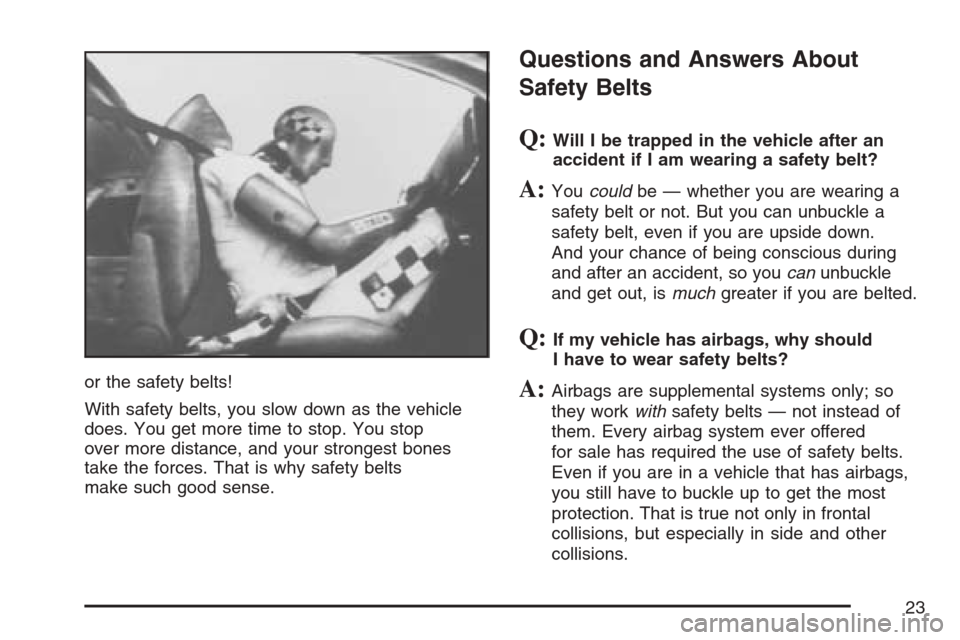
or the safety belts!
With safety belts, you slow down as the vehicle
does. You get more time to stop. You stop
over more distance, and your strongest bones
take the forces. That is why safety belts
make such good sense.
Questions and Answers About
Safety Belts
Q:Will I be trapped in the vehicle after an
accident if I am wearing a safety belt?
A:Youcouldbe — whether you are wearing a
safety belt or not. But you can unbuckle a
safety belt, even if you are upside down.
And your chance of being conscious during
and after an accident, so youcanunbuckle
and get out, ismuchgreater if you are belted.
Q:If my vehicle has airbags, why should
I have to wear safety belts?
A:Airbags are supplemental systems only; so
they workwithsafety belts — not instead of
them. Every airbag system ever offered
for sale has required the use of safety belts.
Even if you are in a vehicle that has airbags,
you still have to buckle up to get the most
protection. That is true not only in frontal
collisions, but especially in side and other
collisions.
23
Page 104 of 492
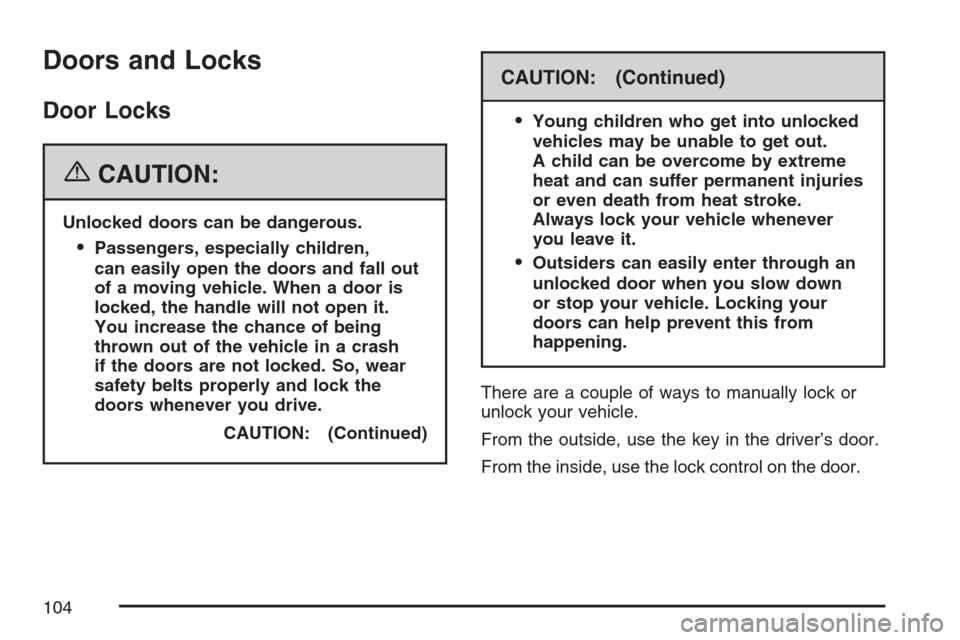
Doors and Locks
Door Locks
{CAUTION:
Unlocked doors can be dangerous.
Passengers, especially children,
can easily open the doors and fall out
of a moving vehicle. When a door is
locked, the handle will not open it.
You increase the chance of being
thrown out of the vehicle in a crash
if the doors are not locked. So, wear
safety belts properly and lock the
doors whenever you drive.
CAUTION: (Continued)
CAUTION: (Continued)
Young children who get into unlocked
vehicles may be unable to get out.
A child can be overcome by extreme
heat and can suffer permanent injuries
or even death from heat stroke.
Always lock your vehicle whenever
you leave it.
Outsiders can easily enter through an
unlocked door when you slow down
or stop your vehicle. Locking your
doors can help prevent this from
happening.
There are a couple of ways to manually lock or
unlock your vehicle.
From the outside, use the key in the driver’s door.
From the inside, use the lock control on the door.
104
Page 109 of 492

Windows
{CAUTION:
Leaving children, helpless adults, or pets
in a vehicle with the windows closed is
dangerous. They can be overcome by
the extreme heat and suffer permanent
injuries or even death from heat stroke.
Never leave a child, a helpless adult, or a
pet alone in a vehicle, especially with the
windows closed in warm or hot weather.
109
Page 111 of 492

Theft-Deterrent Systems
Vehicle theft is big business, especially in some
cities. Although your vehicle has a number of
theft-deterrent features, we know that nothing we
put on it can make it impossible to steal.
Content Theft-Deterrent
To activate the theft-deterrent system:
1. Open the door.
2. Lock the door with the power door lock switch
or the remote keyless entry transmitter. If you
are using the remote keyless entry transmitter,
the door does not need to be open.
3. Close all doors.
Once armed, the alarm will go off if someone
tries to enter the vehicle without using the remote
keyless entry transmitter or a key or turns the
ignition on with an incorrect key. The horn
will sound and the turn signal lamps will �ash
for approximately two minutes.When the alarm is armed, the trunk may be
opened with the remote keyless entry transmitter.
The power door lock switches are disabled
and the doors remain locked. You must use your
remote keyless entry transmitter or your key to
unlock the doors when the system is armed.
Arming with the Power Lock Switch
The alarm system will arm when you use either
power lock switch to lock the doors while any door
or the trunk is open and the key is removed
from the ignition.
Arming with the Remote Keyless
Entry Transmitter
The alarm system will arm when you use your
remote keyless entry transmitter to lock the doors,
if the key is not in the ignition.
111
Page 117 of 492
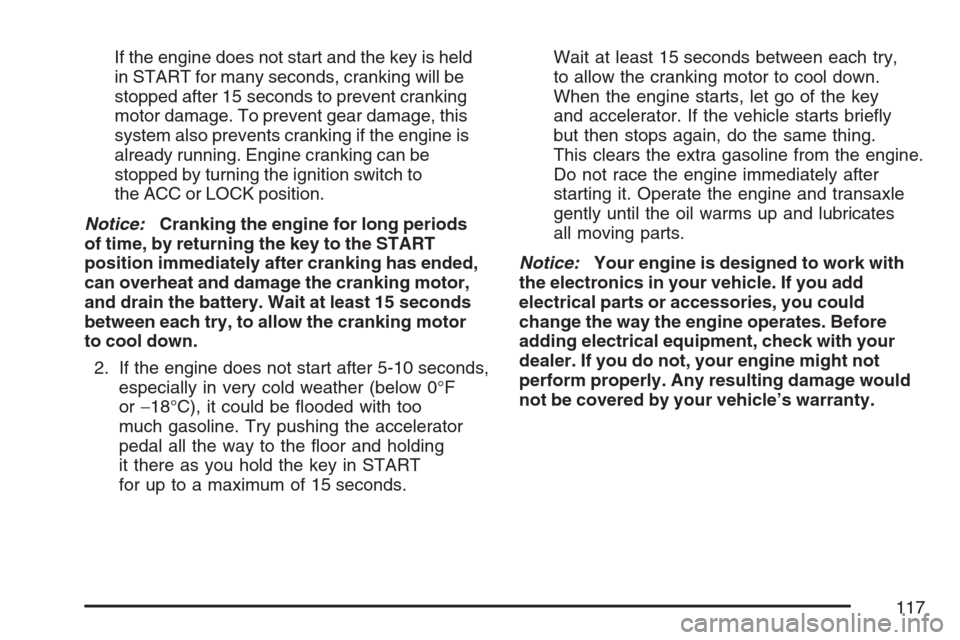
If the engine does not start and the key is held
in START for many seconds, cranking will be
stopped after 15 seconds to prevent cranking
motor damage. To prevent gear damage, this
system also prevents cranking if the engine is
already running. Engine cranking can be
stopped by turning the ignition switch to
the ACC or LOCK position.
Notice:Cranking the engine for long periods
of time, by returning the key to the START
position immediately after cranking has ended,
can overheat and damage the cranking motor,
and drain the battery. Wait at least 15 seconds
between each try, to allow the cranking motor
to cool down.
2. If the engine does not start after 5-10 seconds,
especially in very cold weather (below 0°F
or−18°C), it could be �ooded with too
much gasoline. Try pushing the accelerator
pedal all the way to the �oor and holding
it there as you hold the key in START
for up to a maximum of 15 seconds.Wait at least 15 seconds between each try,
to allow the cranking motor to cool down.
When the engine starts, let go of the key
and accelerator. If the vehicle starts brie�y
but then stops again, do the same thing.
This clears the extra gasoline from the engine.
Do not race the engine immediately after
starting it. Operate the engine and transaxle
gently until the oil warms up and lubricates
all moving parts.
Notice:Your engine is designed to work with
the electronics in your vehicle. If you add
electrical parts or accessories, you could
change the way the engine operates. Before
adding electrical equipment, check with your
dealer. If you do not, your engine might not
perform properly. Any resulting damage would
not be covered by your vehicle’s warranty.
117
Page 132 of 492
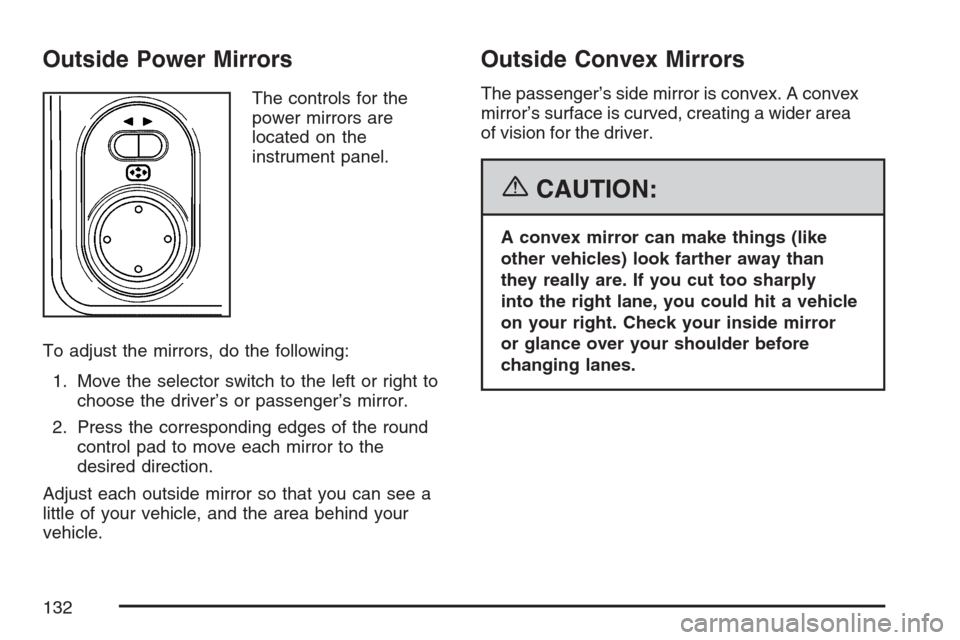
Outside Power Mirrors
The controls for the
power mirrors are
located on the
instrument panel.
To adjust the mirrors, do the following:
1. Move the selector switch to the left or right to
choose the driver’s or passenger’s mirror.
2. Press the corresponding edges of the round
control pad to move each mirror to the
desired direction.
Adjust each outside mirror so that you can see a
little of your vehicle, and the area behind your
vehicle.
Outside Convex Mirrors
The passenger’s side mirror is convex. A convex
mirror’s surface is curved, creating a wider area
of vision for the driver.
{CAUTION:
A convex mirror can make things (like
other vehicles) look farther away than
they really are. If you cut too sharply
into the right lane, you could hit a vehicle
on your right. Check your inside mirror
or glance over your shoulder before
changing lanes.
132
Page 136 of 492

OnStar®service cannot work unless your vehicle
is in a place where OnStar®has an agreement
with a wireless service provider for service in
that area. OnStar
®service also cannot work
unless you are in a place where the wireless
service provider OnStar
®has hired for that area
has coverage, network capacity and reception
when the service is needed, and technology that
is compatible with the OnStar
®service. Not all
services are available everywhere, particularly
in remote or enclosed areas, or at all times.
OnStar
®service that involves location information
about your vehicle cannot work unless GPS
satellite signals are unobstructed and available
in that place as well.Your vehicle must have a working electrical
system (including adequate battery power) for the
OnStar
®equipment to operate. There are other
problems OnStar®cannot control that may prevent
OnStar®from providing OnStar®service to you
at any particular time or place. Some examples are
damage to important parts of your vehicle in an
accident, hills, tall buildings, tunnels, weather
or wireless phone network congestion.
Your Responsibility
You may need to increase the volume of your
radio to hear the OnStar®advisor. If the light
next to the OnStar®buttons is red, this means
that your system is not functioning properly
and should be checked by a dealer. If the
light appears clear (no light is appearing), your
OnStar
®subscription has expired. You can
always press the OnStar®button to con�rm
that your OnStar®equipment is active.
136
Page 159 of 492
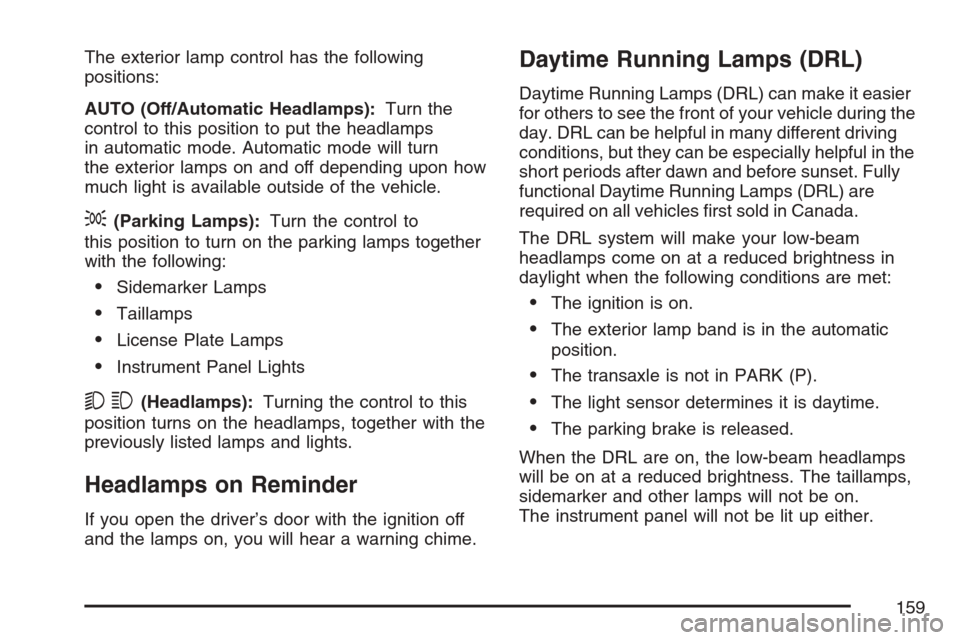
The exterior lamp control has the following
positions:
AUTO (Off/Automatic Headlamps):Turn the
control to this position to put the headlamps
in automatic mode. Automatic mode will turn
the exterior lamps on and off depending upon how
much light is available outside of the vehicle.
;(Parking Lamps):Turn the control to
this position to turn on the parking lamps together
with the following:
Sidemarker Lamps
Taillamps
License Plate Lamps
Instrument Panel Lights
53(Headlamps):Turning the control to this
position turns on the headlamps, together with the
previously listed lamps and lights.
Headlamps on Reminder
If you open the driver’s door with the ignition off
and the lamps on, you will hear a warning chime.
Daytime Running Lamps (DRL)
Daytime Running Lamps (DRL) can make it easier
for others to see the front of your vehicle during the
day. DRL can be helpful in many different driving
conditions, but they can be especially helpful in the
short periods after dawn and before sunset. Fully
functional Daytime Running Lamps (DRL) are
required on all vehicles �rst sold in Canada.
The DRL system will make your low-beam
headlamps come on at a reduced brightness in
daylight when the following conditions are met:
The ignition is on.
The exterior lamp band is in the automatic
position.
The transaxle is not in PARK (P).
The light sensor determines it is daytime.
The parking brake is released.
When the DRL are on, the low-beam headlamps
will be on at a reduced brightness. The taillamps,
sidemarker and other lamps will not be on.
The instrument panel will not be lit up either.
159
Page 192 of 492
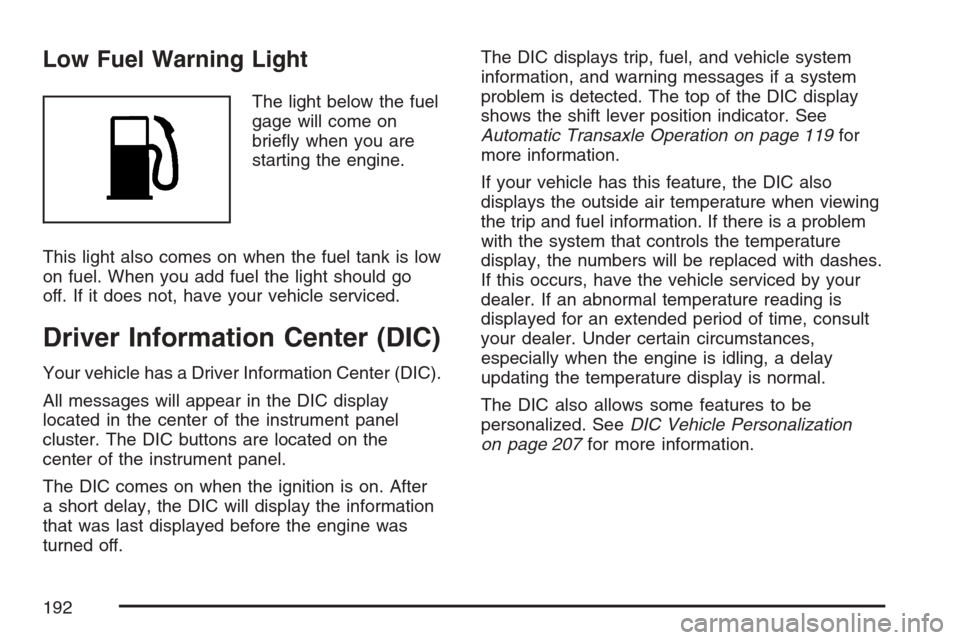
Low Fuel Warning Light
The light below the fuel
gage will come on
brie�y when you are
starting the engine.
This light also comes on when the fuel tank is low
on fuel. When you add fuel the light should go
off. If it does not, have your vehicle serviced.
Driver Information Center (DIC)
Your vehicle has a Driver Information Center (DIC).
All messages will appear in the DIC display
located in the center of the instrument panel
cluster. The DIC buttons are located on the
center of the instrument panel.
The DIC comes on when the ignition is on. After
a short delay, the DIC will display the information
that was last displayed before the engine was
turned off.The DIC displays trip, fuel, and vehicle system
information, and warning messages if a system
problem is detected. The top of the DIC display
shows the shift lever position indicator. See
Automatic Transaxle Operation on page 119for
more information.
If your vehicle has this feature, the DIC also
displays the outside air temperature when viewing
the trip and fuel information. If there is a problem
with the system that controls the temperature
display, the numbers will be replaced with dashes.
If this occurs, have the vehicle serviced by your
dealer. If an abnormal temperature reading is
displayed for an extended period of time, consult
your dealer. Under certain circumstances,
especially when the engine is idling, a delay
updating the temperature display is normal.
The DIC also allows some features to be
personalized. SeeDIC Vehicle Personalization
on page 207for more information.
192
Page 208 of 492

Entering the Feature Settings Menu
1. Turn the ignition on and place the vehicle in
PARK (P).
To avoid excessive drain on the battery, it is
recommended that the headlamps are
turned off.
2. Press the vehicle information button until
FEATURE SETTINGS PRESS
VTO
SELECT appears on the DIC display.
3. Press the set/reset button to enter the feature
settings menu.
If the menu is not available, FEATURE
SETTINGS AVAILABLE IN PRK (Park) will
display. Before entering the menu, make sure
the vehicle is in PARK (P).
Feature Settings Menu Items
The following are personalization features that
allow you to program settings to the vehicle:
DISPLAY ENGLISH
This feature will only display if a language other
than English has been set. This feature allows
you to change the language in which the DIC
messages appear to English.Press the vehicle information button until the
PRESS
VTO DISPLAY ENGLISH screen appears
on the DIC display. Press the set/reset button to
display all DIC messages in English.
DISPLAY LANGUAGE
This feature allows you to select the language in
which the DIC messages will appear.
Press the vehicle information button until DISPLAY
LANGUAGE appears on the DIC display. Press
the set/reset button to access the settings for this
feature. Then press the vehicle information
button to scroll through the following settings:
ENGLISH (default):All messages will appear
in English.
FRANCAIS (French):All messages will appear
in French.
ESPANOL (Spanish):All messages will appear
in Spanish.
NO CHANGE:No change will be made to this
feature. The current setting will remain.
Choose one of the available settings and press
the set/reset button while it is displayed on the
DIC to select it.
208